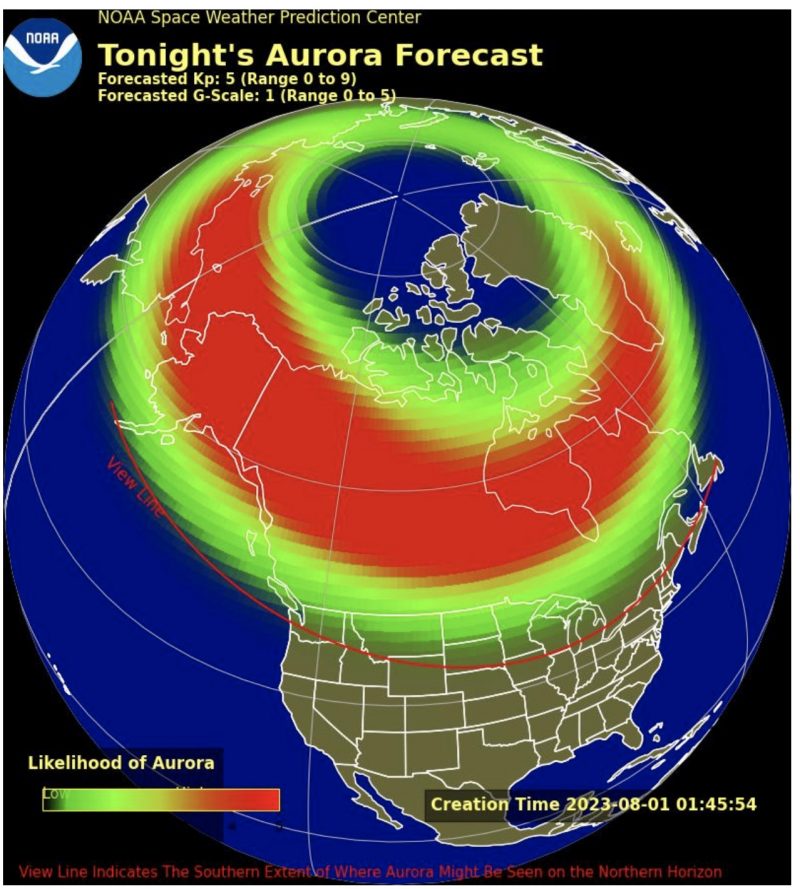Sun activity for August 31, 2023. It’s more than just flares
Sun activity is low. But our friend the sigmoid, or S-shaped filament, erupted again, producing a bright flare and sending some ejecta into space. And we’ve seen an intricate dance around the sun’s north pole, involving a solar tornado. As described in this article in Science, solar tornados are blisteringly hot and about a thousand times larger than their earthly counterparts. A solar tornado results from the forces in the solar corona flinging a filament around. From this perspective, the structure looks similar to a tornado here on Earth. Hence the name.
Last 24 hours: Sun activity continues low. The sun produced eight flares between 11 UTC yesterday and 11 UTC today: five Cs and three Bs. The largest was a C3.0 flare from sunspot AR3413 in the sun’s northwest quadrant at 23:28 UTC on August 30. The lead flare producer of the period was sunspot AR3415, which blasted three flares. The sun has six labeled active regions. There is a newcomer in the northeast now numbered AR3418.
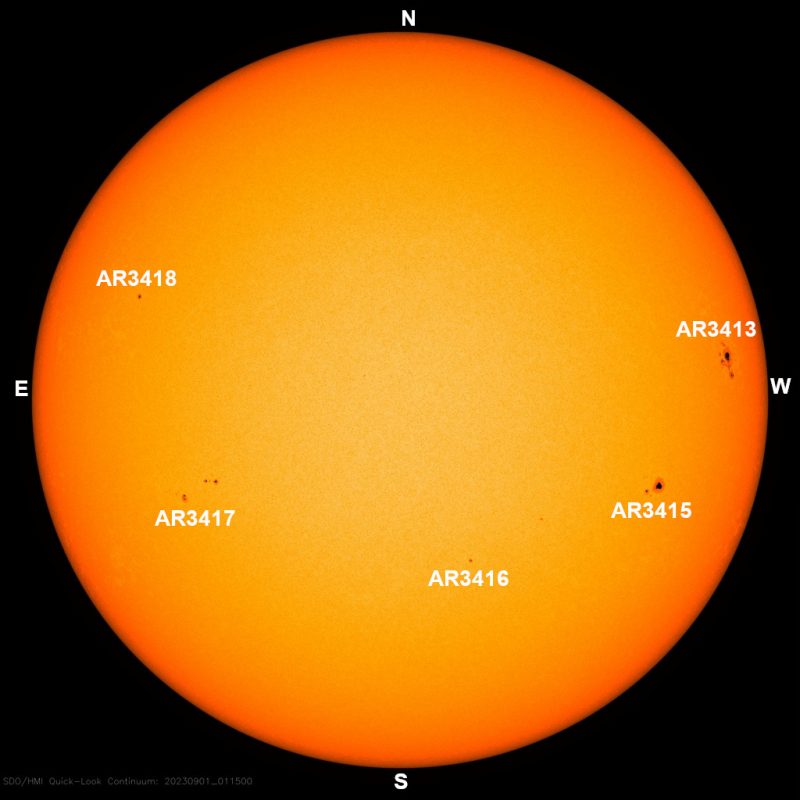
Sun activity for August 30, 2023 is low: Plus, a mixed-up sunspot
Low sun activity continues, with only C and B flares. Meanwhile, we observed some strangeness from sunspot AR3413. As it transits the Earth-facing solar disk, it appears a bit mixed up. Normally, sunspots have a specific polarity (north-south magnetic alignment) in the northern hemisphere, with the opposite polarity in the southern hemisphere. The strong tendency of sunspots to have opposite polarities in opposite hemispheres is called the Hale polarity. And what’s cool is that the polarities reverse, with each new solar cycle. Now check out the imagery above, where green and blue represent one polarity and red and yellow represent the opposite polarity. AR3413 started off its journey from the sun’s limb (edge) with the polarity of a southern hemisphere spot. Then it transformed into a northern hemisphere polarity during its journey across the disk. Very interesting!
Last 24 hours: Sun activity remains low. Eight flares were produced between 11 UTC yesterday and 11 UTC today: five Cs and three Bs. The largest was a C4.0 flare from sunspot AR3417 in the southeast at 23:27 UTC on August 29. This sunspot region shares the lead flare producer crown, with an unlabeled sunspot in the northeast. Both produced three flares over the past day. The sun currently has five labeled active regions, including a newcomer now numbered AR3417. By the way, near the center of the solar disk, a filament followed the path of a sigmoid (S-shaped) structure. Take a look in the imagery below. You can see a lot of motion along the filament. And just to the west of this structure, a filament erupted on and off over the past day, hurling some ejecta into space.
Sun activity for August 29, 2023, is low, but filaments and prominences keep going.
Low sun activity continues, but filaments and prominences are still adorning the solar limb (edge). We saw activity particularly in the northeast quadrant, where a magnificent prominence hurled out ejecta – see it in the above imagery. This region looks pretty active, as it kept flaring all day long. Also on the northern limb, a long-lasting prominence close to the solar pole kept dancing the whole day, forming an almost complete arc as plasma was ejected and returned to the sun. Check it out in the imagery below. There are more active regions coming into view; stay with us as we wait for an increase in activity.
Last 24 hours: Sun activity is low. During the past day the sun again released only C and B flares, although the number of flares has increased. There were 12 C and three B flares between 11 UTC yesterday and 11 UTC today. The largest event was a C2.3 flare by an incoming region on the northeast limb that has not yet been numbered. The event occurred at 23:59 UTC on August 28. This sunspot region was also the lead flare producer of the day, with six C and two B flares. The sun currently has five labeled active regions.
Sun activity for August 28, 2023 is low, but lots of filaments and prominences
We are nearing solar maximum in the next year or two. But you wouldn’t know it from looking at the sun over the past 24 hours. Sun activity is low. It’s almost very low. In the past day, there was only one C flare. The only other flare was a B flare. What we do see is a lot of filament and prominence activity. There were no filament eruptions, but filaments are dancing all along the sun’s limb (edge). Why is the sun so quiet, when we are so near solar maximum? It’s just a period of quiet amongst the storms. Stay tuned. It’ll change soon.
Last 24 hours: Sun activity is low. The sun released one C flare and one B flare during the past day, between 11 UTC yesterday and 11 UTC today. The largest was a C1 flare from just behind the sun’s west limb (edge), AR3405, at 3:54 UTC on August 28, 2023. Today, the sun has five labeled active regions.
Sun activity for August 27, 2023 is moderate. Plus, a double filament eruption
The sun produced back-to-back filament eruptions that were fun to see. The first was from sunspot region AR3411. The second erupted slightly south of that, from behind the sun’s limb (edge). We think newly departed sunspot region AR3405 might have caused the second filament. Both eruptions were on the sun’s west limb (edge), so any coronal mass ejections (CMEs) would not be Earth-directed. Overall, sun activity increased momentarily to moderate with the production of an M1.1 flare from over the sun’s east limb (edge). The M flare was a long-duration event, lasting more than six hours. Afterwards, sun activity calmed. By the way, longer-duration flares are indicative of CMEs. But this one was far behind the limb, so the CME would not be Earth-directed.
Last 24 hours: Sun activity is moderate. The sun released one M flare and four C flares during the past day, between 11 UTC yesterday and 11 UTC today. The largest was an M1.1 flare from just behind the sun’s east limb (edge) at 22:30 UTC on August 26, 2023. Region AR3415 continues to show a beta-delta magnetic configuration. Today, the sun has five labeled active regions.
Sun activity for August 26, 2023: Sunspot AR3405 departs with a double blast
Sun activity is back to low with the production of only C flares, but there is an active region on the northwest limb (edge) that doesn’t want to leave without being noticed. Sunspot AR3405 produced a double flare, jets and fiery prominences. It blasted out a C1.3 flare at 15:36 UTC on August 25 and rapidly thereafter a C5.3 at 15:49 UTC. Both explosions produced gorgeous prominences; in the animation you can see the second one. On the southeast, we see a coming sunspot that promises fiery activity for itself and its vicinity. We saw high activity during the past day even before this sunspot got a number. It has now been labeled AR3416.
Last 24 hours: Sun activity is low. The sun blasted only five C flares during the past day, between 11 UTC yesterday and 11 UTC today. The largest was a C5.0 flare exploding from sunspot AR3405 at 15:49 UTC yesterday. The lead flaring producer of the period was sunspot AR3405, which blasted out three flares plus a series of sub flares, jets and prominences. Active regions AR3415 and AR3413 are the largest active regions on the solar disk. Region AR3415 shows a beta-delta magnetic configuration. Today, the sun bears six labeled active regions with the addition of newcomer AR3416 in the southeast limb (edge).
Sun activity for August 25, 2023: M flare! Activity rises to moderate
Sun activity has risen to moderate with an M1.5 flare at 1:09 UTC on August 25 by AR3415. We’ve been watching this region, along with AR3413, since they were beyond the solar horizon in the northeast, and they are now the largest sunspot regions on the Earth-viewed solar disk. While we mentioned yesterday that AR3413 was under consideration to be split into two regions, specialists have now decided that it will remain as a single sunspot. This is because it has now lost the additional spots that made it candidate for a split. Elsewhere on the sun, AR3405 blasted flares all day long in the northwest, producing jets and prominences. We saw three of them being hurled into space – take a look at our imagery below. Finally, the SOHO spacecraft’s LASCO C2 instrument captured Regulus, the brightest star of constellation Leo the Lion, coming out from behind the occulter. The occulter is a disk that covers the sun to allow us to better image the sun’s surroundings, where we can see events like coronal mass ejections (CMEs).
Last 24 hours: Sun activity is moderate with the production of an M flare. Between 11 UTC yesterday and 11 UTC today, the sun produced only 13 flares. The largest was the above-mentioned M1.5 flare blasted by AR3415 on the southeast quadrant. The explosion occurred at 1:09 UTC on August 25. Shortly after the M flare, a corresponding R1 (minor) radio blackout was registered, affecting an area over the Pacific Ocean between Japan and Hawaii. The lead flaring producer of the period was sunspot AR3405, which blasted six flares, while AR3415 is the largest active region on the solar disk. Today the sun bears five labeled active regions.
Sun activity for August 24, 2023: Dancing prominences all around the horizon
Sun activity returns to low with the production of only C flares, but we saw dancing prominences all around the sun’s limb (edge). The west solar horizon was adorned with them, both in the north and the south. This activity is from recently departed sunspots and filaments that have just rotated out of view to the far side of our sun. We also saw action in the northeast in the form of floating plasma and prominences. These prominences came from sunspots sitting just behind the horizon, so – since the east limb is rotating into view – they’re a sign of possible action to come! For now we’re watching the recently arrived AR3413 and AR3415, which are the largest sunspots on the solar disk. Similar to the case of AR3405, which was recently split into two active regions (AR3405 and AR3411), specialists are suggesting that AR3413 is actually two active regions. However, they need it to rotate into a more frontal location to perform the analysis required to make this decision.
Last 24 hours: Sun activity is back to low. Between 11 UTC yesterday and 11 UTC today, the sun produced only 11 C flares. The largest was a C3.9 blasted by sunspot AR3405 on the northwest quadrant. The explosion occurred at 14:07 UTC on August 23. The lead flare producer prize goes to AR3403, which produced four blasts during the last 24 hours. The sun currently bears seven labeled active regions, with no newcomers today.
Sun activity for August 23, 2023: Action on the up with an M flare!
After days of low activity, action has finally increased with an M1.1 flare. We were expecting activity to pick up through the the two eastern newcomers that have attracted our attention in recent days, but it was actually the northwest quadrant that brought the excitement. Sunspot region AR3405 started things off with a C1.6 around 11 UTC on August 22. It continued to be active through the day, with a huge exploding filament in its vicinity ending at 23:04 UTC with the M1.1 blast that brought sun activity to moderate. We hadn’t seen an M flare since sunspot AR3387 produced an M3.6 on August 8! The southwest quadrant responded with a gorgeous prominence at 2:04 UTC on August 23, which came from an exploding filament near AR3404. Check out our animation below to see the ejecta that it hurled into space. Turning back to the east, the southeastern newcomer finally turned the the corner onto the Earth-viewed side of the sun. That meant that specialists could finally assign it a number: meet AR3415. It looks like a large active region, but it’s still located too close to the limb (edge) for scientists to provide an accurate classification. Stay tuned.
Last 24 hours: Sun activity is moderate. Between 11 UTC yesterday and 11 UTC today, we saw one M flare and nine Cs for a total of ten flares during the period. As mentioned above, the largest was an M1.1 flare by AR3405 at 23:04 UTC on August 22. Shortly after the M flare an R1 (minor) radio blackout was registered, affecting an area east of Hawaii over the Pacific Ocean. The honor of lead flare producer for the day goes to AR3405, which blasted six flares including the M. Currently, our star has eight numbered active regions on its Earth-facing side. Two are newcomers: AR3414, which appeared from nowhere on the northeast quadrant, and the newly numbered AR3415 in the southeast, which is looking big!
Sun activity for August 22, 2023: Simultaneous double prominence in the east
Sun activity today is low, but wow! A simultaneous double prominence! The event was a result of two C flares blasted by the two newcomer sunspot regions we mentioned yesterday. Out of the two flares, the one in the southeast was the largest. In fact, as a C5.7 flare, it was the largest flare of the past day. The sunspot that produced it is still located beyond the solar horizon, so it does not have a number yet. Specialists are waiting for it to rotate around the corner to give it a number. The newcomer in the northeast did receive a number, and is now called AR3413. Turning to the northwest, the sun granted us some jets and prominences from AR3403 and a recently departed active region far beyond the solar horizon.
Last 24 hours: Sun activity is low. Between 11 UTC yesterday and 11 UTC today, we saw 12 C flares. As mentioned above, the largest was a C5.7 flare at 0:00 UTC on August 22, by an as-yet-unnumbered active region. This sunspot blasted eight C flares from behind the solar horizon in the southeast to become the lead flare producer. Currently, our star has eight numbered active regions on its Earth-facing side. There is a newcomer on the northeast now numbered AR3413.
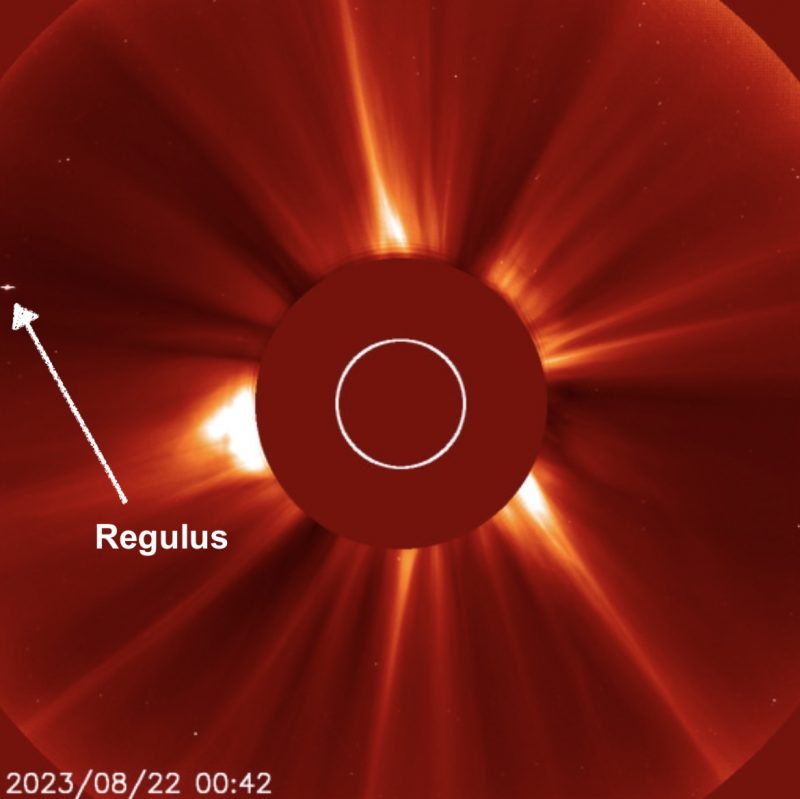
Sun activity for August 21, 2023: Parker Solar Probe Venus flyby today
You wouldn’t think so … but it’s extra hard to send spacecraft inward toward our sun. Extra boosts of energy are required. And today NASA’s Parker Solar Probe will fly past Venus – the planet next-inward from Earth – for the 6th time during its mission to reach the sun. This is Venus flyby #6 out of 7, due to be completed at 12:02 UTC on August 21, 2023, just an hour after the closing time of this writing. Parker Solar Probe launched on August 12, 2018. Its true purpose is to unlock mysteries of the sun’s corona and solar wind. So today Parker Solar Probe completes Venus flyby #6. And the mission completed its most recent perihelion – its closest point to the sun, perihelion #16 – on June 22, 2023. On that day, it flew only 5.3 million miles (8.5 million km) from the sun’s surface. Over the seven years of its mission, Parker Solar Probe will complete 24 orbits around the sun. At its closest approach, it’ll come within about 3.9 million miles (6.2 million km) of the sun. That’s some seven times closer than any previous mission, and it’s why NASA sometimes says that Parker Solar Probe is the first spacecraft to touch the sun. In fact, the craft has touched the sun already, according to NASA. It accomplished that feat when it swooped inside the sun’s outer atmosphere, or corona, at its 8th perihelion on April 28, 2021.
Last 24 hours: Sun activity is low. Between 11 UTC yesterday and 11 UTC today, we saw 11 C flares. The largest was a C4.4 flare – from an incoming active region on the southeast that has not not been numbered yet – just exploded at 07:53 UTC on August 21, 2023. The two active regions that blasted the gorgeous loop prominence we reported yesterday have just turned the corner on the sun’s east (incoming) limb. Action picking up with these two guys? We’ll keep watching. The award for lead flare producer of the past day was shared between these two not-yet- numbered active regions. Currently, our star shows six numbered active regions on its Earth-facing side.
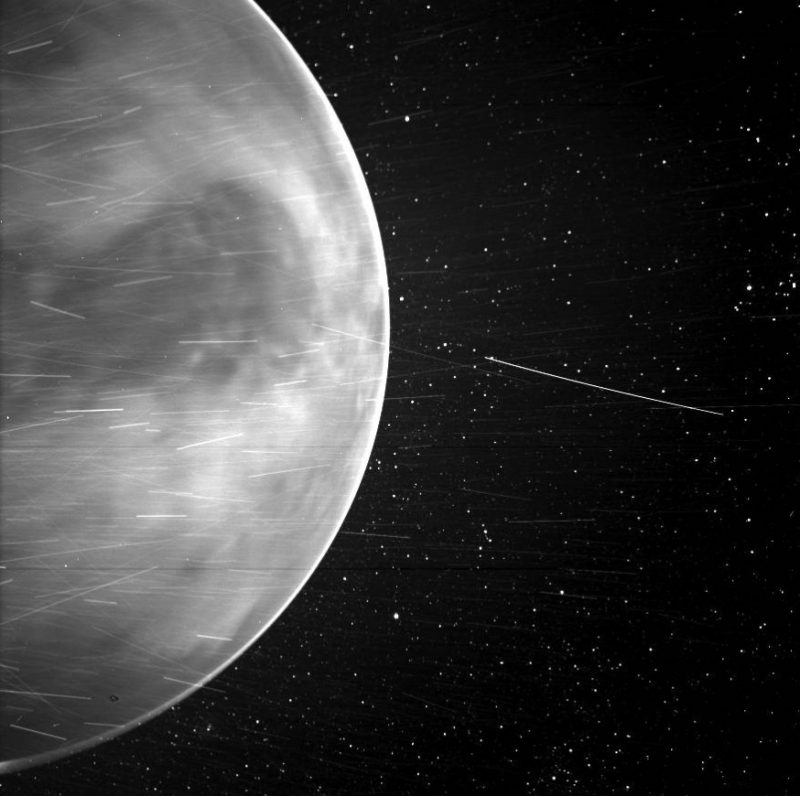
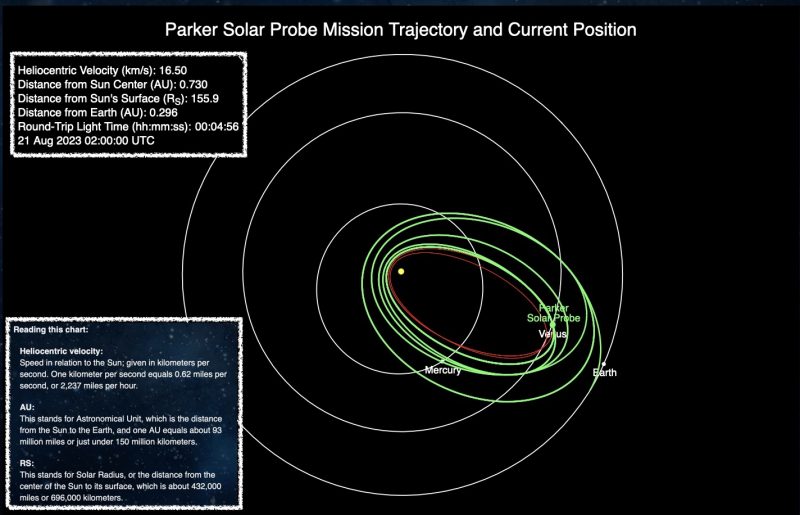
Sun activity for August 20, 2023: Fiery prominence from sun’s far side
Sun activity continues low. But we did see a large filament explosion, forming an arc beyond the solar east limb (edge). It was an enormous loop of plasma! Take a look at our animation. It ended with a magnificent prominence, just above the sun’s equator on its east horizon. The prominence loop started to form at around 9 UTC on August 19 and ended at around 11:30 UTC. Promises for action? We’ll see.
Last 24 hours: Sun activity is low. Between 11 UTC yesterday and 11 UTC today, we saw only six C flares. At the time of this writing, active region AR3409 on the northwest exploded a C3.7 flare at 06:36 UTC on August 20, 2023. The explosion is associated with a coronal mass ejection (CME), but we’ll need to wait for the modeling and analysis to find out if a component is coming our way. This event was the largest flare of the past day (11 UTC yesterday to 11 UTC today). The award for lead flare producer of the past day is split between sunspots AR3409, yesterday’s leader, and AR3403. Both exploded two C flares each. Currently, our star shows seven numbered active regions on its Earth-faced side. All are stable or in decay.
Sun activity for August 19, 2023: C5.8 flare produces a bright burst
Sun activity was low just before this writing, but then active region AR3406 exploded with a C5.8 flare. The bright burst, which blasted from the sun at 06:40 UTC today, August 19, looked like a diamond winking in the light. On the other hand, also on the west limb but farther north, AR3409 blasted out three lesser C flares. After a minor C1.8 flare, AR3409 produced a C3.7 at 19:30 UTC. Then, shortly after, AR3409 released a C3.0 flare at 21:35 UTC. This C flare produced sent dark ejecta into space, meaning the plasma that flew into space was colder than its surroundings. We need to wait until specialists go through modeling and analysis on these three flares to determine if any coronal mass ejections (CMEs) were directed at us. Elsewhere on the sun, the troll-lookalike, long-lasting prominences came to an end as the trolls vanished. But now, new, long-lasting prominences appear all over the north limb (edge). We saw four of them, including floating plasma in the northeast. All this happened while the sun was relatively “calm.” Stay tuned for more sun news.
Last 24 hours: Sun activity is low. Between 11 UTC yesterday and 11 UTC today, we saw only four C flares. The largest event was a C5.8 flare by active region AR3406 on the southwest quadrant. The explosion occurred at 06:40 UTC today, August 19. Sunspot AR3409 was the lead flare producer. It produced three of the four C flares. Currently our star presents eight numbered active regions. All are stable, presenting an alpha or beta magnetic configuration. There is a newcomer on the northeast limb (edge) now numbered AR3412.
Sun activity for August 18, 2023: Fiery prominence. Sunspot AR3405 splits
Sun activity remains low, with only C flares. But AR3397 blasted a C5.1 flare on the northwest at 12:40 UTC on August 17 that produced a fiery prominence. The LASCO C2 imagery instruments on the SOHO spacecraft registered the event and a narrow coronal mass ejection (CME). After modeling and analysis, the CME was found to not be Earth-directed. During the event, we saw a couple of long-lasting prominences that have been there for the past day. With a bit of imagination, they look like two trolls running away from the eruption, climbing uphill to reach the solar north pole! Returning to our discussion of sunspot region AR3405 yesterday, specialists have now decided to split it into two separate active regions. The west part of it will remain identified as AR3405 while the eastern area will be numbered as AR3411. Both are stable for now.
Last 24 hours: Sun activity remains low. Between 11 UTC yesterday and 11 UTC today, we saw only 12 C flares. The largest event was the C5.1 mentioned above that produced a gorgeous prominence. The lead flare producer of the day was an as-yet-unnumbered region on the southeast quadrant. It produced six C flares. AR3410 and AR3411 show an alpha magnetic configuration while the rest present a beta complexity. All are stable. Currently the sun bears seven numbered active regions on its Earth-faced side. Unusually, as mentioned above, today we have an old-newcomer, so to speak: AR3411, formerly part of AR3405.
Sun activity for August 17, 2023: Double jet from beyond horizon
Sunspot region AR3394 said farewell this morning, with a C3.6 flare from behind the solar horizon. And the sun itself blocked some of the explosion, so it could have been larger than C3.6. The event was notable because it was a double blast; imagery shows two jets being hurled into space simultaneously from two different places in the vicinity of AR3394. The ejecta from both blasts crossed paths as they departed from the sun. However, no coronal mass ejection (CME) is coming our way from this eruption. In other news, specialists are considering whether to split the large sunspot region AR3405 into two separately labeled regions. They need to wait until the sunspot rotates into a more frontal position to complete their analysis and decide if the change is necessary. We will let you know. Finally, Regulus, the brightest star of constellation Leo the Lion, entered the field of view of the SOHO spacecraft’s LASCO C3 instrument. This bright star will be in transit behind the sun in LASCO C3 imagery for the next few days.
Last 24 hours: Sun activity remains low, as the sun produced only eight C flares between 11 UTC yesterday and 11 UTC today. The largest was the above-mentioned C3.9 flare, fired at 2:46 UTC on August 16 by AR3394 from behind the solar horizon. AR3395 also blasted three Cs from behind the solar horizon – these guys don’t want to leave! Today the sun bears nine numbered sunspots, including three newcomers: AR3408 and AR3410 in the southwest, and AR3409 in the northwest.
Sun activity for August 16, 2023, is low: 2 sunspots depart, 2 new ones arrive
Sun activity has been low for several days. But we saw a good show of solar fireworks along the sun’s west limb (edge) over the past day, as sunspot AR3395 departed in the northwest. It is being moved by the sun’s rotation to the sun’s far side. Likewise, in the southwest, we saw beautiful coronal loops along the limb adorning AR3394, which is also saying farewell. Meanwhile, there are two newcomers today: AR3406 on the southeast and AR3407 on the southwest. All in all it was a quiet day on the sun, with stable sunspots, most of them showing beta magnetic configurations (a relatively simple magnetic configuration, indicating a low probability for strong flares). Of course, the sun could increase in activity at any moment!
Last 24 hours: Sun activity is low. Sunspot AR3403 was the day’s lead flare producer with six C flares, but it wasn’t active enough to bring sun activity overall up to moderate. Yesterday’s lead producer AR3405 blasted five C flares, including the day’s largest: a C2.9 flare. It was fired at 11:33 UTC on August 15. In all, the sun exploded 14 C flares in the past day (11 UTC yesterday to 11 UTC today). There are now seven labeled sunspot regions on the Earth-facing side of the sun.
Sun activity for August 15, 2023: New sunspot says hi with an almost-M flare
For the past several days, sun activity has been low. We haven’t seen an M flare since August 8. But we were seeing long-lasting prominences arcing up from the sun’s east limb (edge). And now the reason for the prominences has made its appearance. Newcomer sunspot AR3405 has just turned the corner, rotating into view on our star’s east side. And, as soon as we could see it, it blasted a hello-I’m-here C9.0 flare, almost an M flare. AR3405’s salute took place at 21:10 UTC on August 14. It produced a coronal mass ejection (CME). But, due to AR3405’s location on the extreme east horizon of our sun, the CME isn’t coming our way. This guy, AR3405, is the next active region to keep watching. And there’s another long-lasting prominence on the sun’s east limb just south of this newcomer. So it looks like, at last, some increased action might be coming our way. Stay with us for more sun news.
Last 24 hours: Sun activity remains low. We’re still seeing only C flares. But we did see an increase in flare production over the past day (11 UTC yesterday to 11 UTC today), with 13 C flares produced. The largest was AR3405’s C9.0 flare, very near the M-flare boundary. AR3405 was also the lead flare producer of the day, with seven flares out of the day’s 13. There are six labeled sunspot regions on the Earth-facing side of the sun today.
Sun activity for August 14, 2023: Waiting, waiting for action
The August 13-14 sun was even quieter than that of the day before. We had half as many flares as the previous observation period (11 UTC one day to 11 UTC the next). There are few sunspot regions on the Earth-facing solar disk. Those that are there have low magnetic configurations, either alpha or beta. So not much excitement there. The one exception is region AR3395 with a delta region. This region produced three of the five flares recorded in the last 24 hours. As we wait for regions from the opposite side of the sun to rotate into view, AR3395 has the most promise for substantial flaring even if the overall chances are low. In the meantime, we’ll see if any of the filaments on the sun or the current coronal hole bring auroral excitement to Earth. Stay tuned!
Last 24 hours: The solar calm continues. We observed only five C flares. The largest flare was a C2.1 from AR3395 at 22:34 UTC on August 14, 2023. The Earth-facing sun has six numbered sunspot regions.
Sun activity for August 13, 2023, is still low. STEREO A comes home
Welcome home, STEREO A! The STEREO A (Solar TErrestrial Relations Observatory) spacecraft has orbited the sun for 17 years. It has now reached Earth in its orbit for the first time since its launch in 2006. As its acronym suggests, there were two STEREO spacecraft, A and B. The two launched together from Kennedy Space Center in 2005, leaving Earth in opposite directions around the sun. In 2011, they provided the first-ever stereoscopic view of the sun, the first view from two perspectives at once. It was the first time we’d seen our star as a sphere. Sadly, shortly after the two reached the other side of the sun, and their orbits crossed, controllers lost contact with STEREO B. But STEREO A kept going, and going. Its orbit around the sun – at a distance from the sun similar to Earth’s – ultimately carried back toward Earth itself. STEREO A “lapped” us on August 12, 2023. It will now continue its orbit around the sun and could make it back around again – to sweep past Earth again – in another 17 years. Way to go, STEREO A.
Last 24 hours: The sun was even calmer over these past 24 hours than the day before. Looking over the long term, today’s sun doesn’t appear as what we’d call a quiet sun, like one we’d see during solar minimum. But, in contrast to last week’s sun, crackling with M and X flares, today’s sun is very calm and quiet. Its visible face has only four numbered sunspot regions. We saw 11 C flares over the past day (11 UTC yesterday to 11 UTC today). The largest flare of the past day was a C5.2 – from AR3395 – that happened at 23:44 UTC yesterday (August 12). Sunspot region AR3395 in the northwest produced the largest number of flares, seven C flares out of the 11.
Sun activity for August 12, 2023, is low. Faint flares, nice prominences
The sun is calm. It produced only faint C flares during the past day. But prominences – anchored in the sun’s photosphere, extending outward into its hot outer corona – continue around the sun’s visible edge. Those on the east (incoming) edge announce possible action coming from the sun’s far side. Prominences on the west (retreating) side recall past glories (now perhaps continuing – unseen by us – on the far side). There are two newcomer sunspots today, but they remain inactive. The rest of the sunspots on our side of the sun are stable and not showing substantial magnetic complexity. In other words, they don’t appear on the verge of powerful flaring.
Why is the sun so calm? The sun – our mighty star – doesn’t confine itself to Earth’s daily or weekly increments of marking time. It operates on its own schedule. And during this period of calm, the sun continues to build toward the peak of the current solar cycle – known as Solar Cycle 25 to us earthlings – expected in the mid-2020s. So the action might increase at any moment!
Sun activity for August 11, 2023 still low. Prominences take center stage
Sun activity remains low, with smaller-sized flares, but the number of flares has increased. And a nice prominence erupted from the sun’s northeast limb (edge) at around 6 UTC on August 11. It blasted some ejecta into space, but, due to its location, the ejecta is not Earth-directed. Meanwhile, the long-lasting prominence we’ve been watching – on the sun’s southeast limb (edge) – has come to an end. Zzzz.
Last 24 hours: Sun activity is low with only C flares. But the number of flares increased to 18. The largest event of the past day (11 UTC yesterday to 11 UTC today) was a C8.3 flare from AR3395, at 6:45 UTC on August 11. AR3398 became the lead flare producer of the day with ten C flares. Sunspot group AR3395 kept its magnetic complexity with a beta-gamma configuration. AR3394 and AR3399 have a beta configuration, and the rest of the regions are alpha (not much magnetic complexity; hence, a low flaring potential). The sun has six labeled active regions on the Earth-facing side of our sun. No newcomers today.
Sun activity for August 10, 2023, is low, with a long-lasting prominence
With sun activity still low, prominences have been the real attention-grabbers over the past day (11 UTC yesterday to 11 UTC today). The prominence on the sun’s southeastern limb (edge) is especially noteable. It has been hovering in the corona for the past day, with some material escaping the sun and then reforming. Thus, this prominence produced a small southward-directed coronal mass ejection (CME). By the way, the S1 (minor) solar radiation storm created by the August 7 X flare is still going. It’s impacting radio communications around Earth’s North Pole and is expected to last for the rest of today.
Last 24 hours: Sun activity is low. We saw only six C flares over the past day. The largest event was a C5.5 flare from AR3398, at 2:42 UTC on August 10. Active regions AR3398 and AR3399 are the leading flare producers of the day, with two C flares each. Sunspot group AR3395 showed some growth in its magnetic complexity with a beta-gamma configuration. The greater the magnetic complexity, the greater the chance for flaring. AR3394 has a beta configuration, and the rest of the regions are alpha (not much magnetic complexity; hence, a low flaring potential). There are currently seven labeled active regions on the Earth-facing side of our sun. One, AR3399, is a newcomer in the southeast.

Sun activity for August 9, 2023: The calm after the storms, CME misses Earth
Sun activity has suddenly returned to low after yesterday’s X and M flares. Flare productivity lowered to just 10 C flares, although one of these – a C8.8 at 18:10 UTC on August 9 from AR3394 – nearly reached the M flare threshold. We saw activity on the southeast limb (edge), where long-lasting prominences danced all day long. This activity will soon rotate our way from beyond the solar horizon, bringing potential action. On Earth, the expected hit from a coronal mass ejection (CME) never arrived. The CME from August 5 did not provide even a glancing blow. However, there’s a small chance that the CMEs produced by yesterday’s X and M flares will have minor impacts on Earth. These may produce conditions for a G1 (minor) geomagnetic storm tomorrow.
Last 24 hours: Sun activity is low with only C class flares. The sun produced ten C flares over the past day (11 UTC yesterday to 11 UTC today). The largest was a C8.8 flare at 18:10 UTC from AR3394. But AR3387 was the lead flare producer, with five C flares. The sun currently has seven labeled active regions. They remain stable, with only alpha and beta magnetic configurations.
Sun activity for August 8, 2023. BAM! Another X flare from AR3386
Sun activity is high! And sunspot region AR3386 – which just rotated off the Earth-facing side of the sun – produced an X1.5 flare from beyond the northwest solar horizon at 20:46 UTC (15:46 CDT) on August 7. X flares are the strongest category of solar flares. And this flare might be stronger than X1.5, as the sun itself blocked part of it. The flare was a long-duration event. It produced an S1 radiation storm, which can be seen as snow on SOHO‘s LASCO C2 imagery. And it produced an R3 (strong) radio blackout that started at around 20:37 UTC over the west coast of Mexico and ended at approximately 21:51 UTC over the east coast of Hawaii. Due to AR3386’s location beyond the sun’s west limb (edge), the coronal mass ejection (CME) hurled outward during the X flare is probably not Earth-bound. But stay tuned as we wait for analysis, as there’s still a chance that part of the CME might brush past Earth. By the way, it’s worth noting that AR3386 already gave us an X1.6 flare on August 6.
Last 24 hours: Sun activity is high with the release of an X1.5 flare, plus five Ms and 12 C flares during the past day (11 UTC yesterday to 11 UTC today). We saw a very busy northwest, with the majority of the events coming from that area. Here’s a breakdown of the X and M flares (all these flares occurred on August 7 except the M3.6 flare, which was fired on August 8):
M1.0 by AR3387 at 16:11 UTC, R1 (minor) radio blackout over Puerto Rico.
M1.0 by AR3387 at 16:26 UTC, R1 (minor) radio blackout over Puerto Rico.
M1.0 by AR3386 at 16:27 UTC, R1 (minor) radio blackout over Puerto Rico.
M1.4 by AR3387 at 19:51 UTC, R1 (minor) radio blackout over Dominican Republic.
X1.5 by AR3386 at 20:46 UTC. R3 (strong) radio blackout over Mexico and Hawaii.
M3.6 by AR3387 at 9:31 UTC, R1 (minor) radio blackout over the Red Sea.
The lead flare producer of the period was AR3387, launching 13 flares: four Ms and nine Cs. AR3386 continued blasting behind the northwest solar horizon, with four total flares including the X1.5. The sun today has eight labeled active regions on its Earth-facing side. Three are newcomers: AR3396, AR3397 and AR3398.

Sun activity for August 7, 2023, is moderate: Farewell, AR3386
Sunspot group AR3386 gave us another two M flares before rotating out of view. The largest was an M5.5. The event had a clear coronal mass ejection (CME). Given the location of the region – on the sun’s west limb, on the verge of being rotated out of view – it was probably not Earth-directed. But we are awaiting further analysis. AR3386 is gone, but not forgotten. It and maybe even AR3380 can still give us activity over the sun’s limb (edge). Stay tuned.
Last 24 hours: Sun activity is moderate with the release of an M5.5 flare from AR3386 at 18:20 UTC on August 6. Between 11 UTC yesterday and 11 UTC today, we saw a total of 10 flares: two Ms and eight Cs. The M5.5 flare produced an R2 (strong) radio blackout over the Pacific Ocean. The other M flare, M2.2, was at 4:29 UTC on August 7 from AR3386. It produced an R1 radio blackout over Asia. AR3386 produced the most flares of the past day, with the two Ms and five Cs. AR3386 has rotated out of view. But we might still see additional flares or eruptions from it over the next couple of days. The sun has six numbered active regions today.
Sun activity for August 6, 2023 is high: X flare from AR3386!
X flare! We thought AR3386 had promise, and it did not disappoint. Shortly before the end of the day on August 5, the region released a long-duration X1.6 flare near the sun’s west limb (edge). Long-duration events are usually associated with the launch of a coronal mass ejection (CME). And so it was with this event, although AR3386’s position so near the limb of the sun means there will be no direct CME impact at Earth. Still, Earth could experience a glancing blow from this CME on August 8 or 9. Given the energy already pumped into Earth’s magnetic system in recent days, we could see some more enhanced auroral displays. AR3386 currently has a delta magnetic configuration. This could mean more strong flares. Stay tuned!
Last 24 hours: Sun activity is high with the release of an X1.6 at 22:45 UTC on August 5 from AR3386. Between 11 UTC yesterday and 11 UTC today, we saw a total of 8 flares: one X and 7 Cs. The X flare produced an R3 (strong) radio blackout over the Pacific Ocean. AR3387 produced the most flares with 5 Cs. The sun has seven numbered active regions today.
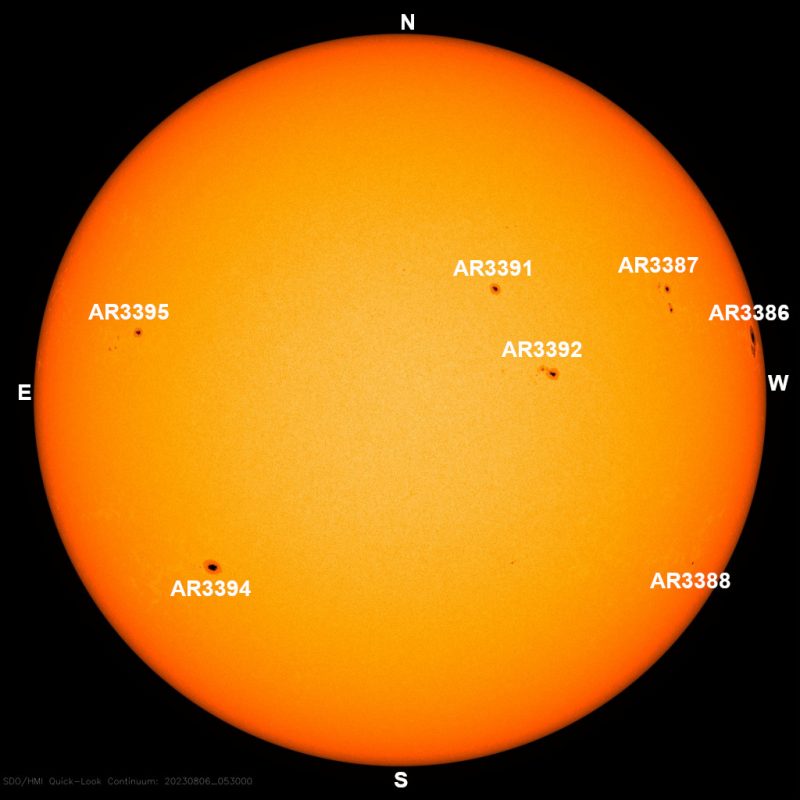
Sun activity for August 5, 2023: G3 geomagnetic storm and auroras!
The expected coronal mass ejection (CME) arrived! And the predicted geomagnetic storm was stronger than anticipated. Expectations were for a G2 (moderate) geomagnetic storm and we received a G3 (strong) storm. BAM! Auroras! The storming threshold was reached at around 3:00 UTC on August 5, 2023. At the time of this writing Earth’s magnetic field is experiencing a G1 (minor) storm. This means auroral displays at northern latitudes, as far south as Oregon and Pennsylvania in U.S. Auroras have been reported in Washington, Colorado, Idaho, Illinois, and Arizona. More opportunities for auroras and geomagnetic storming are coming since yesterday’s M2.0 flare by AR3386 analysis shows a glancing blow on August 7, 2023. Around 6:25 UTC on August 5, 2023, we saw a filament eruption in the vicinity of AR3386 sending material into space thru a jet and prominence. We will let you if a component of this ejecta is coming our way after results of modeling and analysis.
Last 24 hours: Sun activity is moderate. Between 11 UTC yesterday and 11 UTC today, we saw a total of 22 flares: two Ms and 20 Cs. The first M flare was an M1.6 from AR3386 at 07:22 UTC on August 5. Shortly after, an R1 (minor) radio blackout affected an area over the west coast of India. From the very edge of the solar southwest, active region AR3380 remains the lead flare producer. It released eleven C flares and the second M flare during the period. AR3380 is completely behind the west limb (edge). But it managed to give us the largest flare of the day, an M2.0 flare at 09:36 UTC on August 5, 2023. Afterwards, an R1 (minor) radio blackout occurred over the Red Sea. The sun has seven numbered active regions today.
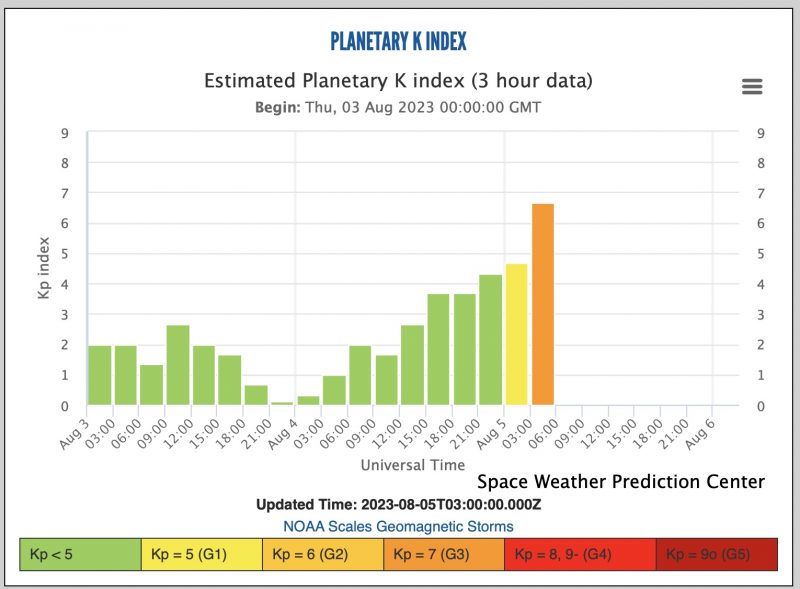
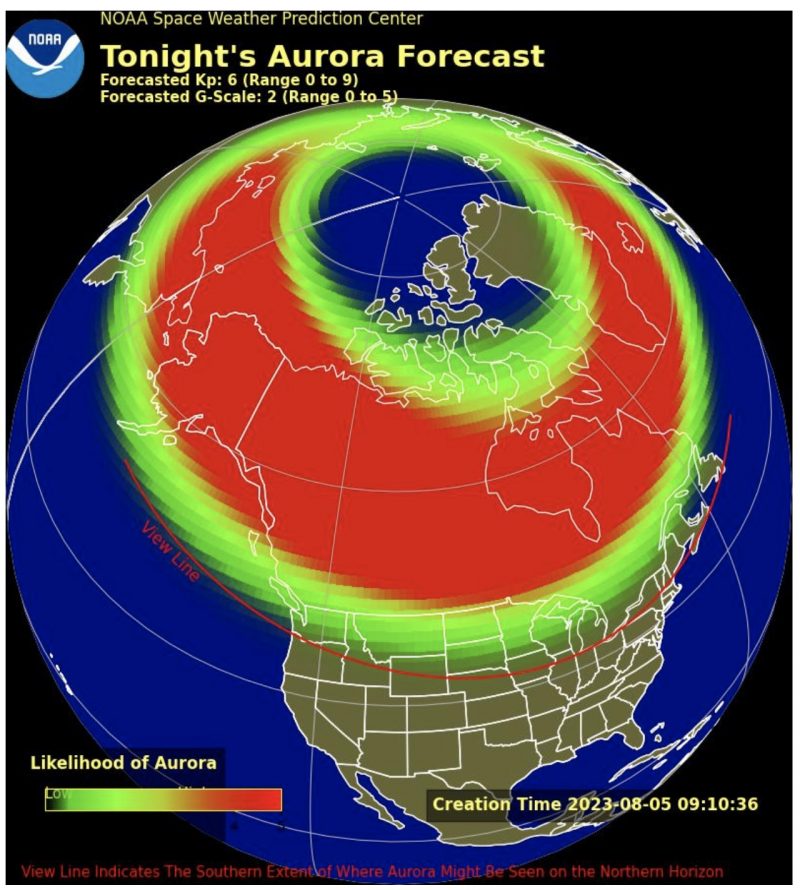
Sun activity for August 4, 2023: AR3380 slips from the limelight
Finally, an M flare from a region other than AR3380! Sunspot region AR3386 produced an M2.0 flare at 4:24 UTC on August 4. But AR3380 – which had been the only M flare producer of the past week – still wasn’t to be beaten, firing off an M2.1 flare. It will soon rotate out of view, though. Who will be its successor? Will it be AR3386? We’ll see. In the meantime, the fiesta of fiery filaments continues in the area around the disk’s center. Just like earlier in the week, this activity is believed to be due to magnetic fields emerging within the the filament channel structure where the filament rests. This is called filament channel activation. Behaviour like this is to be expected with Solar Cycle 25 approaching its maximum.
Last 24 hours: Sun activity is moderate. Between 11 UTC yesterday and 11 UTC today, we saw a total of 15 flares: two Ms and 13 Cs. The largest was an M2.1 flare from AR3380, blasted at 11:55 UTC on August 3. Shortly after, an R1 (minor) radio blackout affected an area over northwest Africa. The second M flare was an M2.0 from AR3386 at 4:24 UTC on August 4. The corresponding R1 (minor) radio blackout affected an area over the South China Sea. The lead flare producer was AR3380 with nine flares: eight Cs and one M. The sun currently has nine labeled active regions. There are two newcomers: AR3394 on the southeast limb (edge) and AR3395 in the northeast.
Sun activity for August 3, 2023 is high! Thanks, sunspot AR3380
Despite the sun’s producing only three M flares, the sheer number of flares – 29 in total over the past day – brings sun activity up to high. Sunspot AR3380 continues its flaring onslaught, firing off 21 of the 26 C flares and all 3 of the M flares. The region has lost its delta configuration, which can be an indicator of M or even X flares. But it has retained some of its magnetic complexity with a beta-gamma structure. It is now nearing the sun’s southwest limb (edge), but we’ll be able to observe its activity for a few more days, even after it passes over the horizon. The filament channel near the Earth-viewed solar disk’s center also continues its activity today, displaying what we call filament channel activation. The channel is the area the filament lies along. Filament channel activation is when the filament continues to regenerate itself as it throws out eruptions in the form of small coronal mass ejections (CMEs). As most of these faint CMEs are Earth-directed, the flurry of small CMEs from the past several days is maintaining the prospect of geomagnetic activity, including possible storming. Stay tuned.
Last 24 hours: Sun activity is high due to the sheer quantity of C and M flares. Between 11 UTC yesterday and 11 UTC today, the sun produced 29 flares: three Ms and 26 Cs. Sunspot AR3380 is the dominant flaring region, with 21 C flares and all three Ms. This is the breakdown of AR3380’s M flares and corresponding R1 (minor) radio blackouts in the past day:
M1.7, the largest, at 14:52 UTC on July 2. R1 (minor) radio blackout over the North Atlantic Ocean.
M1.3 at 16:22 UTC on July 2. R1 (minor) radio blackout over Puerto Rico.
M1.1 at 19:14 UTC on July 2. R1 (minor) radio blackout over the west coast of Mexico.
The sun currently has nine labeled active regions.
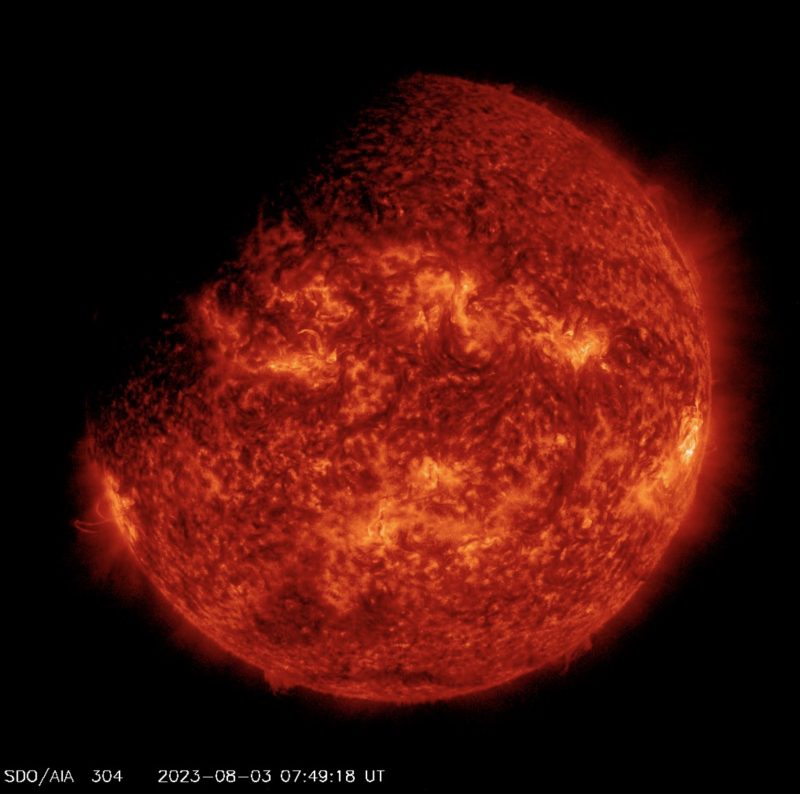
Sun activity for August 2, 2023: M flares and a very active filament
Sun activity remains moderate, with four M flares produced over the past day. The Ms all came from region AR3380, which remains lead flare producer. The long filament we reported yesterday has kept up its activity, erupting around 3 UTC on August 2. The ejecta is under analysis to determine if there is an Earth-directed component. The expected coronal mass ejection (CME) we spoke of yesterday arrived with only a weak impact, causing an unsettled magnetic field but no geomagnetic storm. Specialists still anticipate a slight chance for a G1 (minor) geomagnetic storm later today.
Last 24 hours: Sun activity is moderate. Between 11 UTC yesterday and 11 UTC today, the sun produced 12 flares: four Ms and eight Cs. Sunspot AR3380 is still the lead flare producer with ten of the 12 flares, including the four M flares. The largest of the four was an M1.4 at 14:09 UTC on Aug 1. An R1 (minor) radio blackout affected an area over the North Atlantic Ocean. The second M flare was an M1.0 at 21:51 UTC on Aug 1, producing an R1 radio blackout over Hawaii. The third was an M1.3 at 8:02 UTC on August 2, producing an R1 radio blackout over the south coast of Saudi Arabia. And at the very end of our observation period, AR3380 blasted a fourth: an M1.2 flare at 10:50 UTC on August 2, producing an R1 radio blackout over North Africa. The sun currently has ten labeled active regions, with newcomer AR3393 emerging on the northeast quadrant.

Sun activity for August 1, 2023: Flurry of flares, as we wait for a storm
Sunspot AR3380 gave us six M flares in a row over the past day. Fun! Each M flare produced a corresponding R1 (minor) radio blackout. Here’s the breakdown of AR3380’s M flares and the associated radio blackouts (all times UTC):
M1.0 at 1:56 August 1, R1 over the Mariana Islands.
M1.3 at 2:03 August 1, R1 over the Mariana Islands.
M2.2 at 4:47 August 1, R1 over Cambodia.
M1.3 at 5:37 August 1, R1 over Thailand.
M3.6 at 6:57 August 1, R1 over India.
M1.6 at 9:09 August 1. R1 over the Red Sea.
Meanwhile, here on Earth, G1 (minor) to G2 (moderate) geomagnetic storm is expected today. It’s due to the anticipated arrival of the coronal mass ejection (CME) that the sun hurled our way on July 28. The magnetic cloud might reach us later today, opening an opportunity for auroral displays at northern latitudes. Aurora alert!
Last 24 hours: Sun activity is moderate. Between 11 UTC yesterday and 11 UTC today, the sun produced 17 flares: six Ms and 11 Cs. AR3380 was the leading flare producer, firing off the six Ms and ten of the Cs. We also saw two erupting filaments over the past day. The first was a long filament in the northeast quadrant. It appears it was mostly reabsorbed by the sun, but some of it erupted at around 16 UTC on July 31. The second eruption occurred at around 3 UTC on August 1 in the vicinity of AR3392. Both cases are being analyzed to check for any Earth-bound component. The sun currently has ten numbered active regions on its Earth-viewed side. That includes one newcomer, AR3392, on the northeast close to the equator.
